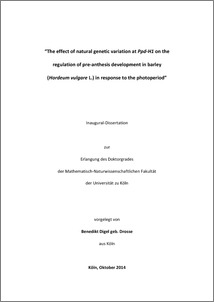Digel geb. Drosse, Benedikt
(2014).
The effect of natural genetic variation at Ppd-H1 on the
regulation of pre-anthesis development in barley
(Hordeum vulgare L.) in response to the photoperiod.
PhD thesis, Universität zu Köln.

![[img]](https://kups.ub.uni-koeln.de/style/images/fileicons/application_pdf.png)  Preview |
|
PDF
B.Digel_Dissertation.pdf
- Accepted Version
Download (7MB)
|
Abstract
The timing of reproductive development determines spike architecture and thus yield in temperate grasses such as barley (Hordeum vulgare L.). Reproductive development in barley is controlled by the photoperiod response gene Ppd-H1 which accelerates flowering time under long-day (LD) conditions. A natural mutation in Ppd-H1 prevalent in spring barley causes a reduced photoperiod response, and thus, late flowering under LD. However, it is not very well understood how LD and Ppd-H1 control pre-anthesis development, and thus spike architecture and yield in barley.
This work reports about morphological and molecular changes in the leaf and at the shoot apex of barley in response to the photoperiod and genetic variation at Ppd-H1. Expression variation in the leaf and main shoot apices (MSA) were analyzed using RNA-sequencing and qRT-PCR in the three spring barley cultivars Scarlett, Bowman and Triumph and derived introgression lines. The spring barley lines were characterized by the natural mutation in Ppd-H1, whereas the derived introgression lines carry the photoperiod responsive, dominant wild type Ppd-H1 allele introduced from wild or winter barley.
LD and the dominant Ppd-H1 allele accelerated all phases of shoot apex development, but had the strongest effect on inflorescence maturation. Photoperiod-shift experiments revealed that the duration of the vegetative and early reproductive phase determined the number of spikelet primordia and seeds per spike. Whereas in Arabidopsis a few long days are sufficient for floral commitment, in barley flowering only occurred under continuous LD exposure. Short-day (SD) did not prevent floral transition, but impaired inflorescence development and caused the abortion of the main shoot inflorescence. Consequently, long photoperiods and the dominant Ppd-H1 allele reduced the number of spikelet primordia, but promoted spikelet fertility and ensured main shoot survival.
In the absence of a complete barley genome reference sequence, we generated a barley reference sequence for improved analysis of a shoot apex specific transcriptome from the vegetative and early reproductive phases. Genes differentially regulated during development or in response to day length and variation at Ppd-H1 were classified into 31 co-expression clusters, and characterized by enriched Gene Ontology terms, thus providing a valuable resource for future studies on shoot apex development in barley.
LD and the dominant Ppd-H1 allele caused an up-regulation of the barley orthologs of Flowering Locus T, HvFT1 in the leaf and HvFT2 in the MSA. Both genes were co-regulated with genes involved in nutrient transport and flower fertility, suggesting that improved nutrient mobilization under LD was important to maintain inflorescence development. LD and the dominant Ppd-H1 allele up-regulated the expression of the three AP1/FUL-like MADS box transcription factors, HvVRN1, HvBM3 and HvBM8 and floral homeotic genes homologous to APETALA3, PISTILATA, SEPALLATA1 and 3 of Arabidopsis. Floral development was thus strongly LD dependent. Contrastingly, floral transition correlated with the day-length and Ppd-H1 independent down-regulation of the SHORT VEGETATIVE PHASE-like (SVP-like) genes HvBM1, HvBM10 and HvVRT2 and a Ppd-H1 independent up-regulation of HvSOC1-1 in the MSA. Thus, expression of SVP-like genes and HvSOC1-1 in the MSA seemed to be independent of HvFT1 and HvFT2 expression levels in barley. These results point to differences in the regulation of the floral transition in Arabidopsis, where SOC1 and SVP are regulated by FT.
In summary, our results demonstrate that LD and Ppd-H1 control the number and maturation of floral primordia presumably by up-regulating FT-like genes and improving nutrient mobilization in the leaf and MSA. The study thus lays the foundation to understanding the genetic and molecular control of pre-anthesis development and yield structure in temperate cereals.
| Item Type: |
Thesis
(PhD thesis)
|
| Translated abstract: |
| Abstract | Language |
|---|
| UNSPECIFIED | German |
|
| Creators: |
| Creators | Email | ORCID | ORCID Put Code |
|---|
| Digel geb. Drosse, Benedikt | drosse@mpipz.mpg.de | UNSPECIFIED | UNSPECIFIED |
|
| URN: |
urn:nbn:de:hbz:38-63627 |
| Date: |
1 September 2014 |
| Language: |
English |
| Faculty: |
Faculty of Mathematics and Natural Sciences |
| Divisions: |
Außeruniversitäre Forschungseinrichtungen > MPI for Plant Breeding Research |
| Subjects: |
Life sciences |
| Uncontrolled Keywords: |
| Keywords | Language |
|---|
| barley, Hordeum vulgare L., flowering, photoperiod, transcriptome profiling, inflorescence development, Ppd-H1, | English |
|
| Date of oral exam: |
14 October 2014 |
| Referee: |
| Name | Academic Title |
|---|
| Coupland, George | Prof. Dr. | | Höcker, Ute | Prof. Dr. |
|
| Refereed: |
Yes |
| URI: |
http://kups.ub.uni-koeln.de/id/eprint/6362 |
Downloads per month over past year
Export
Actions (login required)
 |
View Item |


